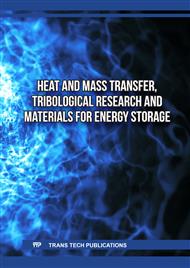p.103
p.113
p.133
p.151
p.157
p.165
p.171
p.177
p.185
The Impact of Varying Radiation Duration in Microwave-Assisted Solvothermal Process on the Capacitive Properties of N-Doped rGO/CuCr2O4 Composites
Abstract:
Energy storage devices have become essential in modern life, and supercapacitors are among the prominent choices. Reduced graphene oxide (rGO) is a promising material for electrochemical double layer capacitors (EDLC). However, its drawback lies in its relatively lower electrical conductivity compared to pristine graphene. Doping mechanism utilizing nitrogen could enhance the electrical conductivity of rGO. In parallel, CuCr2O4 has been identified as a suitable material for pseudocapacitor. In this study, hybrid supercapacitors of EDLC and pseudocapacitor were fabricated through the utilization of N-doped rGO/CuCr2O4 composites. The fabrication process involved varying the duration of microwave-assisted solvothermal radiation at 180 W to synthesize N-doped rGO, with variations of 30, 45, and 60 minutes. The impact of varying radiation duration on the structures and morphologies of the materials was investigated using X-Ray Diffractometer (XRD), Fourier-Transformed InfraRed (FTIR), Scanning Electron Microscope (SEM), and Energy Dispersive Spectroscope (EDS) instruments. The capacitive properties of the fabricated supercapacitors were evaluated through Cyclic Voltammetry (CV) and Electrochemical Impedance Spectroscopy (EIS). From the CV measurements, the specific capacitances of the supercapacitors synthesized with radiation durations of 30, 45 and 60 minutes were found to be 397.72 Fg-1, 245.79 Fg-1, and 237.74 Fg-1, respectively. The specific capacitance values were strongly influenced by the electrical conductivities of the materials, which were measured as 0.2, 0.18, and 0.13 Scm-1 for radiation durations of 30, 45, and 60 minutes, respectively. It was observed that longer radiation durations appeared to induce structural damage to the material, leading to decreased conductivity in the resulting material.
Info:
Periodical:
Pages:
185-196
Citation:
Online since:
October 2025
Price:
Сopyright:
© 2025 Trans Tech Publications Ltd. All Rights Reserved
Share:
Citation:


